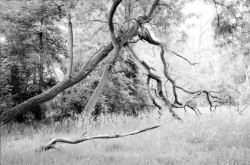Well now,
I've read more of the HC-110 leaflet and although it's packed with information, it does seem to be a source of confusion. Whoever wrote it seems to be struggling to reconcile the clear presentation of metric units and the higgley-piggldey units forced on an infant USA by the Tyrant George III.
They do head their tables as ratio of stock-to-water and concentrate-to-water. Under this heading, 1:1 does correctly mean one unit of agent and one of water. In the usual system, of concentrate-to-final volume it's meaningless - it means one-oneth. That it, one. The final volume equals the final volume. True. but on the far side of unhelpful.
Putting aside the idea that poor teaching of maths is not blame, could this eccentricity of Kodak's be to blame for the confusion?
It does seem to be an odd thing to quote. It's not as though water were a precious commodity. Surely we are interested in the active ingredient's volume, because that has a direct influence on the developer's activity, and the final volume, because that is determined by the size of the tank or tray.


